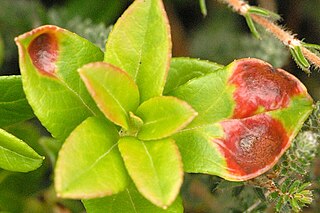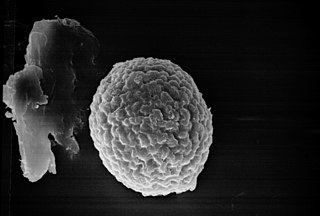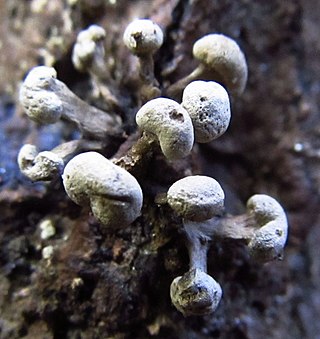Related Research Articles

The Ustilaginomycotina is a subdivision within the division Basidiomycota of the kingdom Fungi. It consists of the classes Ustilaginomycetes and Exobasidiomycetes, and in 2014 the subdivision was reclassified and the two additional classes Malasseziomycetes and Moniliellomycetes added. The name was first published by Doweld in 2001; Bauer and colleagues later published it in 2006 as an isonym. Ustilagomycotina and Agaricomycotina are considered to be sister groups, and they are in turn sister groups to the subdivision Pucciniomycotina.
Eballistra lineata is a fungal plant pathogen that causes stem smut in rice.

Pucciniomycotina is a subdivision of fungus within the division Basidiomycota. The subdivision contains 9 classes, 20 orders, and 37 families. Over 8400 species of Pucciniomycotina have been described - more than 8% of all described fungi. The subdivision is considered a sister group to Ustilaginomycotina and Agaricomycotina, which may share the basal lineage of Basidiomycota, although this is uncertain due to low support for placement between the three groups. The group was known as Urediniomycetes until 2006, when it was elevated from a class to a subdivision and named after the largest order in the group, Pucciniales.

The Exobasidiomycetes are a class of fungi sometimes associated with the abnormal outgrowths of plant tissues known as galls. The class includes Exobasidium camelliae Shirai, the camellia leaf gall and Exobasidium vaccinii Erikss, the leaf and flower gall. There are eight orders in the Exobasidiomycetes, including the Ceraceosorales, Doassansiales, Entylomatales, Exobasidiales, Georgefischeriales, Malasseziales, Microstromatales and the Tilletiales. Four of the eight orders include smut fungi. The families Ceraceosoraceae and Malasseziaceae were formally validated in 2009 for the orders Ceraceosorales and Malasseziales, respectively.

The Entylomatales are an order of smut fungi in the class Exobasidiomycetes. A monotypic order, it consists of a single family, the Entylomataceae. Both the family and order were circumscribed in 1997.

The Tilletiales are an order of smut fungi in the class Exobasidiomycetes. It is a monotypic order, consisting of a single family, the Tilletiaceae, which contains seven genera. The roughly 150 species in the Tilletiales all infect hosts of the grass family, except for species of Erratomyces, which occur on legumes.
The Agaricostilbomycetes are a class of fungi in the subdivision Pucciniomycotina of the Basidiomycota. The class consists of a single order, six families, and 15 genera. Most species are known only from their yeast states. Where known, basidiocarps (fruitbodies) are typically small and stilboid (pin-shaped).

The Atractiellomycetes are class of fungi in the Pucciniomycotina subdivision of the Basidiomycota. The class consists of a single order, the Atractiellales, which contains 3 families, 10 genera, and 58 species.
The Classiculomycetes are a class of fungi in the Pucciniomycotina subdivision of the Basidiomycota. The class contains a single order, the Classiculales, which in turn contains the single family Classiculaceae. The family contains two monotypic genera.
The Cryptomycocolacomycetes are a class of fungi in the Pucciniomycotina subdivision of the Basidiomycota. The class contains a single order, the Cryptomycocolacales, which in turn contains the single family Cryptomycocolacaceae. The family has two monotypic genera.
The Cystobasidiomycetes are class of fungi in the subdivision Pucciniomycotina of the Basidiomycota. The class contains six orders: Buckleyzymales, Cyphobasidiales, Cystobasidiales, Erythrobasidiales, Naohideales, and Sakaguchiales.

The Microbotryomycetes are class of fungi in the Pucciniomycotina subdivision of the Basidiomycota. Until recently, the class contained four orders: the Heterogastridiales, the Leucosporidiales, the Microbotryales, and the Sporidiobolales, which contained a total of 4 families, 25 genera, and 208 species. The order Kriegeriales, containing two families, Kriegeriaceae and Camptobasidiaceae, was defined in 2012.

The Mixiomycetes are a class of fungi in the Pucciniomycotina subdivision of the Basidiomycota. The class contains a single order, the Mixiales, which in turn contains a single family, the Mixiaceae that circumscribes the monotypic genus Mixia. Only one species has been described to date, Mixia osmundae; this species was originally named Taphrina osmundae by Japanese mycologist Toji Nishida in 1911. It is characterized by having multinucleate hyphae, and by producing multiple spores on sporogenous cells.

The Pucciniomycetes are a class of fungi in the Pucciniomycotina subdivision of the Basidiomycota. The class contains 5 orders, 21 families, 190 genera, and 8016 species. It includes several important plant pathogens causing forms of fungal rust.
The Quambalariaceae are a family of fungi in the class Exobasidiomycetes. The family contains the single genus Quambalaria, which in turn contains five species. Quambalaria was circumscribed in 2000 to accommodate plant pathogenic species—previously classified in Ramularia and Sporothrix—that were known to infect Corymbia trees in Australia, causing a leaf spot and shoot blight and canker disease.
Kondoaceae is a family of fungi in the order Agaricostilbales. The family contains two genera. Most species are known only from their yeast states. Hyphal teleomorphs produced in culture have auricularioid basidia.
Robert Bauer was a German mycologist, specialising in rust (Uredinales) and smut (Ustilaginomycetes) fungi.

The Helicobasidiales are an order of rust fungi in the class Pucciniomycetes. It contains the single family Helicobasidiaceae, which itself comprises three genera: Helicobasidium, Stypinella, and Tuberculina. Helicobasidiales was circumscribed in 2006.

The Urocystidales are an order of fungi within the class Ustilaginomycetes. The order contains 6 families and about 400 genera. They are a sister order to Ustilaginales.

The Platygloeales are an order of rust fungi in the class Pucciniomycetes. It contains two families, the Eocronartiaceae and also the Platygloeaceae.
References
- ↑ "Volvocisporium triumfetticola (M.S. Patil) Begerow, R. Bauer & Oberw. 2001". MycoBank. International Mycological Association. Retrieved 2011-10-21.
- ↑ Begerow D, Bauer R, Oberwinkler F (2001). "Muribasidiospora: Microstromatales or Exobasidiales?". Mycological Research. 105 (7): 798–810. doi:10.1017/S0953756201004208.